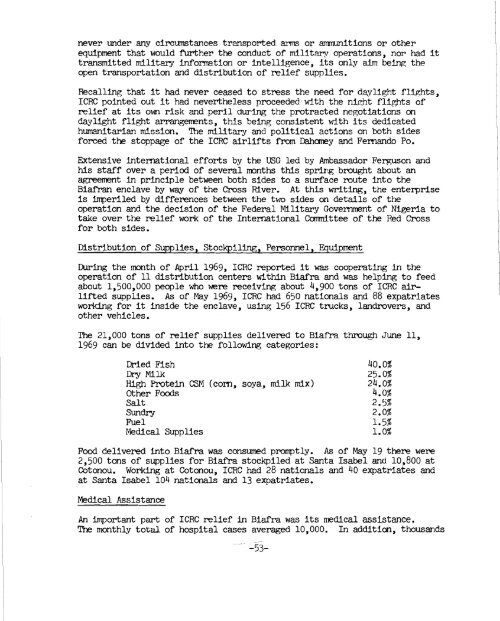3. - usaid
3. - usaid
3. - usaid
You also want an ePaper? Increase the reach of your titles
YUMPU automatically turns print PDFs into web optimized ePapers that Google loves.
never under any circumstances transported.m or amnunitions or other<br />
equipment that would further the conduct of military operations, nor had it<br />
transmitted military infomtion or intelligence, its only aim being the<br />
open transportation and distribution of relief supplies.<br />
Recalling that it had never ceased to stress the need for daylight flights,<br />
ICRC pointed out it had nevertheless proceeded with the night flig$ts of<br />
relief at its own risk and peril during the protracted negotiations on<br />
daylight flight amangeents, this being consistent with its dedicated<br />
humanitarian mission. The military and political actions on both sides<br />
forced the stoppage of the ICRC airlifts from Dahomey and Fernando Po.<br />
Extensive international efforts by the USG led by Ambassador Ferffuson and<br />
his staff over a period of several months this sprir~p; brought abut an<br />
agreement in principle between both sides to a surface mute into the<br />
Biafran enclave by way of the Cross River. At this writing, the enterprise<br />
is imperiled by differences between the tvro sides on details of the<br />
operation and the decision of the Federal Military Government of Nigeria to<br />
take over the relief work of the International Cormittee of the Red Cross<br />
for both sides.<br />
Mstribution of Supplies, Stockpiling, Personnel, Equipment<br />
During the month of April 1969, ICRC reported it was cooperating in the<br />
operation of 11 distribution centers within Biafra and was helping to feed<br />
about 1,500,000 people who were receiving about 4,900 tons of ICRC aLrlifted<br />
supplies. As of May 1969, ICRC had 650 nationals and 88 expatriates<br />
working for it inside the enclave, using 156 ICRC trucks, landmvers, and<br />
other vehicles.<br />
The 21,000 tons of relief supplies delivered to Biafra through June 11,<br />
1969 can be divided into the following categories:<br />
Dried Msh 40.0%<br />
Dry r4il.k 25.0%<br />
High Pmtein CSM (corn, soya, milk mix) 24.0%<br />
Other Foods 4.0%<br />
Salt 2 . 5%<br />
sundry 2 . 0%<br />
me1 1.5%<br />
Medical Supplies 1.0%<br />
Food delivered into Biafra was consumd promptly. As of May 19 there were<br />
2,500 tons of supplies for Biafra stockpiled at Santa Isabel and 10,800 at<br />
Cotonou. Working at Cotonou, ICRC had 28 nationals and 40 expatriates and<br />
at Santa Isabel 104 nationals and 13 expatriates.<br />
Medical Assistance<br />
An important part of ICRC relief in Biafra was its medical assistance.<br />
The monthly total of hospital cases averaged 10,000. In addition, thousands
















